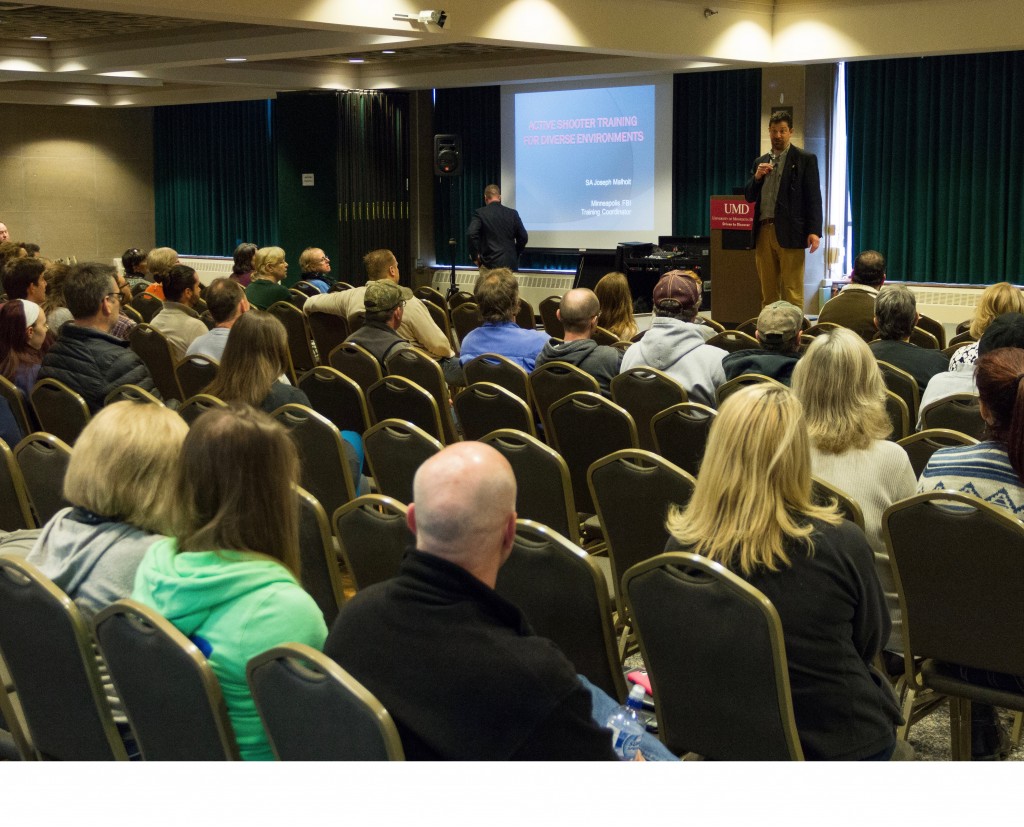BY COLE WHITE | The Statesman | FBI agent Joseph Malhoit gave two lectures on Active Shooter situations to a packed Kirby Ballroom on Thursday, Feb. 25.
“Unfortunately we live in a time where we need to talk about this,” Sean Huls, UMD’s chief of police, said in his introduction.
Malhoit, an 18-year veteran of the FBI, spoke seriously about the problem of mass shootings in his presentation.
“Don’t be paranoid, but be prepared,” Malhoit said.
The main focus of Malhoit’s speech was for individuals to be aware of their surroundings.
“Not every active shooter is 22-years-old with bad acne and a trenchcoat,” Malhoit said.
Part of identifying a problem is to look for early warning signs, including fascination with previous shooters, interest in explosives and a sudden amassing of weapons.
Malhoit’s slides showed the FBI’s statistics on active shooters and emphasized that 69 percent of these situations last less than five minutes before first responders arrive and the attacker is subdued or killed.
The three options in this situation, according to Malhoit, are “Run/Hide/Fight.”
“It’s a menu of options to choose from to survive for five minutes,” Malhoit said.
The goal would be to evaluate your situation and choose the best course of action to help you survive.
“If you can run, I want you running,” Malhoit said. “I want you out of the way and safe.”
If you should find yourself running and meet law enforcement officers, Malhoit suggested to meet them with hands up and fingers out so the officers can identify you as non-threat. Afterwards, Malhoit recommended to run “as far as you need to to feel safe.”
“I don’t want you stopping and doing first aid or offering comfort,” Malhoit said.
The reasoning being that there would be two targets sitting for the attacker.
“And don’t stop because somebody says so,” Malhoit said. “If you ascertain that running is your best chance of survival, by all means do so.”
If hiding is the best option, “you want to be as unappealing and hard to get to as possible,” Malhoit said. Lights out, cell phone on silent and barricaded doors are the best routes, according to Malhoit.
Following that, Malhoit moved on to fighting. “We’re going to turn the tables on this bad guy.” Malhoit suggested improvisational weapons, such as fire extinguishers and chairs, that could be used to ambush the attacker if they entered the room.
“I don’t want you fighting fair,” Malhoit said. “Are they being fair?”
After the presentation, Malhoit and Huls fielded questions from the audience. In response to one question, Huls assured the crowd that “hide in place” is not the standard rule for UMD and agreed with Malhoit’s platforms.
Both men emphasized that while these mass shootings are rare, they are still important to think about. “We call it ‘when lightning strikes,’ because that’s how rare these things do happen,” Huls said. “But you never know. We want to be prepared and have our community as prepared as possible.”

